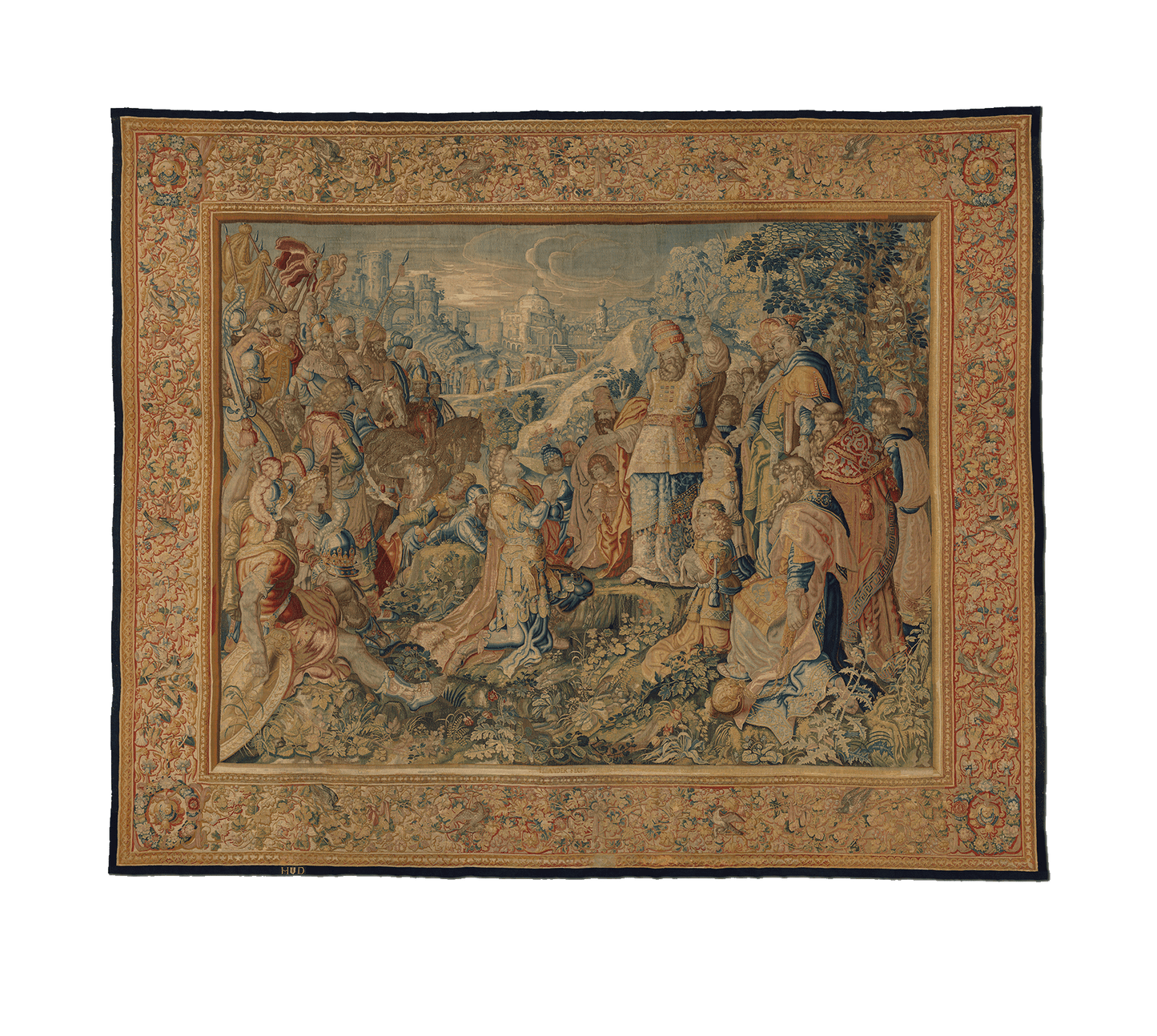Romantic English
The Coronation of the Chosen King RE332515
The Coronation of the Chosen King RE332515
Couldn't load pickup availability
Ah, what a marvelous tapestry we have here, a true feast for the eyes and a narrative woven with the finest of threads! Let's delve into this exquisite work, unraveling its many layers of meaning, artistry, and historical significance.
Foreground and Main Scene: This tapestry is a masterful depiction of a grand and solemn moment—a royal coronation set against the backdrop of a sprawling and ancient city. The scene is brimming with life, with a multitude of figures all focused on the central act of the coronation, which takes place on a raised dais. Here, the king, clad in opulent robes and ornate armor, stands tall and commanding, as if ready to receive the divine right to rule. His pose is one of both humility and authority, his head slightly bowed as he receives the crown from a figure of high religious or noble standing, perhaps a bishop or a high priest.
Surrounding the king are courtiers, soldiers, and attendants, all dressed in the rich and varied garments of their station. The colors of their attire—crimson reds, deep blues, and gleaming golds—are rendered with such precision that one can almost feel the weight of the fabrics and the coolness of the metal armor. Each figure is distinct, their expressions ranging from solemn reverence to eager anticipation, as they bear witness to this momentous occasion.
Background and Setting: The background reveals a cityscape that stretches far into the distance, its buildings and towers bathed in the soft, golden light of dawn or dusk. This is no ordinary city—it is an idealized representation of an ancient, perhaps even mythical, metropolis. The architecture is grand and classical, with towering columns, domes, and arches that speak of a civilization at the height of its power and glory. The artist has skillfully used perspective to create a sense of depth, drawing the viewer’s eye from the intimate foreground to the majestic city that looms in the distance.
Above the city, the sky is a swirl of clouds, painted with delicate shades of grey and gold, suggesting the presence of divine forces watching over the proceedings. The sky itself seems to echo the importance of the event unfolding below, as if the heavens are aligned with the earth in this sacred moment.
The Ceremony: The coronation itself is rich with symbolic meaning. The king, standing atop a stone platform, is at the very center of the composition, elevated both physically and metaphorically above those around him. The act of crowning, performed by the religious figure, symbolizes the divine approval of the king's rule, a concept deeply rooted in the traditions of medieval and Renaissance Europe.
To the left, a group of knights and noblemen, their swords raised in salute, stand in a semicircle, their attention fixed on the new monarch. Their armor glints in the light, a testament to their loyalty and readiness to defend the kingdom. To the right, a procession of clergy and courtiers, some holding ceremonial objects, approach the dais, further emphasizing the sacred nature of the coronation.
Border: The border of the tapestry is a work of art in its own right. It is intricately woven with floral and geometric patterns, interspersed with heraldic symbols—perhaps the coat of arms of the king or the noble house he belongs to. The colors are warm and inviting, with golds and reds predominating, framing the central scene like a golden halo.
At the corners, medallions containing allegorical figures or scenes are placed, perhaps representing the four virtues—Prudence, Justice, Fortitude, and Temperance—that the king is expected to embody. These details serve not only as decoration but also as a reminder of the moral and ethical responsibilities that come with kingship.
Color and Technique: The colors in this tapestry, though aged, still retain a remarkable vibrancy. The artist’s use of shading and hatching techniques creates a sense of realism and depth, bringing the figures to life and giving the scene a three-dimensional quality. The interplay of light and shadow is particularly well-executed, with the light seemingly emanating from the sky above, casting a soft glow on the figures and enhancing the dramatic effect of the coronation.
The weaving technique is nothing short of masterful. The fine gradations of color and the smooth transitions between shades are indicative of a highly skilled workshop, possibly from one of the renowned centers of tapestry production such as Brussels or Flanders in the late 16th or early 17th century. The attention to detail, from the folds of the garments to the expressions on the faces, suggests that this tapestry was commissioned by a patron of significant wealth and status, likely to commemorate an actual coronation or to celebrate the ideals of kingship.
Interpretation: This tapestry is not merely a decorative object; it is a visual manifesto of the divine right of kings, the power of the church, and the unity of the state. It encapsulates the values and beliefs of a time when monarchy was seen as divinely ordained, and the coronation was not just a political act but a sacred rite. The tapestry would have hung in a grand hall, a constant reminder to all who saw it of the legitimacy and authority of the ruler it depicts.
In conclusion, "The Coronation of the Chosen King" is a tapestry that transcends its function as a decorative piece. It is a narrative of power, faith, and the human condition, rendered in the highest form of textile art. It invites the viewer to reflect on the nature of leadership, the responsibilities of those who govern, and the timeless connection between the mortal and the divine.
RE332515
Share


